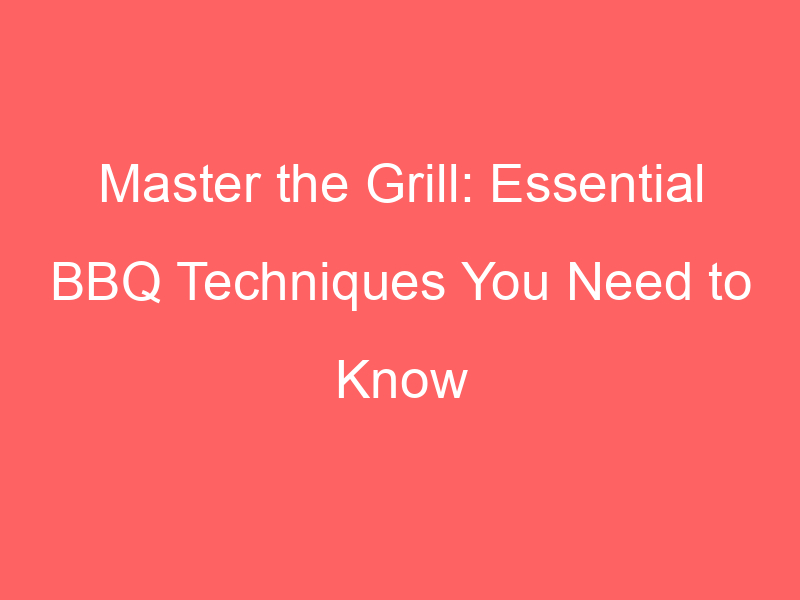Introduction to BBQ Basics Guide
Welcome to our comprehensive guide on BBQ basics. This guide is designed to help you understand the fundamental aspects of BBQ grilling, from the importance of mastering the right cooking techniques to the essential skills every griller should have under their belt. Let’s dive in!
- Understanding the Importance of BBQ Cooking Techniques
- Essential BBQ Skills Every Griller Should Know
- Temperature Control: Learning how to manage the heat on your grill is crucial. Too hot, and your food might burn. Too cool, and it may not cook thoroughly.
- Timing: Different types of meat require different cooking times. Knowing how long to cook each item ensures that everything is done at the same time and cooked to perfection.
- Food Safety: Understanding how to handle and store raw and cooked foods safely is essential to prevent foodborne illnesses.
- Cleaning and Maintenance: Keeping your grill clean and well-maintained not only prolongs its life but also improves the taste of your food.
BBQ cooking techniques are the backbone of a successful grilling experience. They determine the flavor, texture, and overall quality of your BBQ. For instance, slow cooking over indirect heat is a technique that allows the meat to cook evenly, retaining its juices and enhancing its flavor. On the other hand, searing over high heat gives your meat a delicious, crispy crust. Understanding these techniques and knowing when to apply them can significantly improve your BBQ game.
There are a few key skills that every griller should master to ensure a successful BBQ. These include:
By mastering these skills, you’ll be well on your way to becoming a BBQ pro.
BBQ Essentials: Getting Started
When it comes to BBQ, getting started can seem a bit daunting. But don’t worry, we’re here to guide you through the process. The first step in your BBQ journey is choosing the right grill. Let’s dive into it!
Choosing the Right Grill
Choosing the right grill can make a world of difference in your BBQ experience. There are a few key factors to consider, including the type of grill and its size and features. Let’s break it down:
- Gas vs. Charcoal: Pros and Cons
- Understanding Grill Sizes and Features
Gas and charcoal grills are the two most common types, and each has its own set of pros and cons.
| Grill Type | Pros | Cons |
|---|---|---|
| Gas | Easy to use, heats up quickly, clean burning | Can be expensive, lacks smoky flavor |
| Charcoal | Provides a smoky flavor, less expensive | Takes longer to heat, requires more cleanup |
Consider your budget, flavor preferences, and how much time you’re willing to spend on setup and cleanup when deciding between gas and charcoal.
Grill sizes and features can vary greatly. A larger grill might be great for big parties, but it will also take up more space and may be harder to clean. Smaller grills are more portable and easier to manage, but they might not be sufficient for larger gatherings.
As for features, some grills come with built-in thermometers, side burners, and even rotisseries. Think about what kind of cooking you plan to do and choose a grill with features that will support your BBQ goals.
Remember, there’s no one-size-fits-all answer when it comes to choosing the right grill. It’s all about finding what works best for you and your BBQ needs.
BBQ Cooking Basics: Understanding Heat
When it comes to BBQ cooking, understanding heat is crucial. It’s the key to unlocking the full potential of your grill and creating mouth-watering meals. Let’s dive into two fundamental aspects of heat management: Direct vs. Indirect Heat and Managing Grill Temperatures.
- Direct vs. Indirect Heat
Direct and indirect heat are two primary methods of grilling. Knowing when to use each can make a significant difference in your BBQ cooking.
Direct Heat is when you cook your food directly over the heat source. This method is best for foods that cook quickly, like burgers, steaks, and hot dogs. It gives your food a nice sear, locking in the juices and flavors.
Indirect Heat is when you cook your food away from the heat source. This method is ideal for larger or tougher cuts of meat that need to cook slowly, like roasts and whole chickens. It allows your food to cook evenly without burning the outside.
- Managing Grill Temperatures
Managing your grill’s temperature is another crucial aspect of BBQ cooking. It’s not just about turning the knob to high, medium, or low. It’s about understanding how these settings affect your food and adjusting them as needed.
Here are some basic guidelines:
| Temperature Range | Best For |
|---|---|
| High (450-550°F) | Seared steaks, burgers, hot dogs |
| Medium (350-450°F) | Chicken breasts, fish, vegetables |
| Low (250-350°F) | Slow-cooked roasts, ribs, whole chickens |
Remember, these are just guidelines. Every grill is different, and so is every piece of meat. The key is to keep an eye on your food and adjust the heat as needed.
Understanding heat and how to manage it is a fundamental part of BBQ cooking. With these basics, you’re well on your way to becoming a grill master.
Essential BBQ Grilling Techniques
One of the most important techniques in BBQ grilling is searing. This method not only gives your meat a delicious flavor but also a beautiful, appetizing look. Let’s dive into the art of searing and learn how to master it.
Mastering the Art of Searing
- What is Searing and Why is it Important?
- How to Perfectly Sear Meat on the Grill
Searing is a cooking technique where you cook the surface of the meat at high temperature until a caramelized crust forms. This process, known as the Maillard reaction, gives the meat a rich, savory flavor and a visually appealing brown color. Searing is crucial because it locks in the juices of the meat, keeping it moist and tender while it cooks.
Perfect searing requires a bit of practice, but with these steps, you’ll be a pro in no time:
| Step | Instruction |
|---|---|
| 1 | Preheat your grill to a high temperature, around 500°F (260°C). |
| 2 | Season your meat. Salt and pepper are a must, but feel free to add other spices for extra flavor. |
| 3 | Place the meat on the grill. Leave it untouched for a few minutes to allow the sear to form. |
| 4 | Flip the meat only once. Over-flipping can prevent a good sear from forming. |
| 5 | Once both sides are seared, lower the heat or move the meat to a cooler part of the grill to finish cooking. |
Remember, practice makes perfect. The more you sear, the better you’ll get at judging when your meat is perfectly seared and ready to be moved.
BBQ Cooking Methods: Low and Slow
When it comes to BBQ cooking, one method stands out for its ability to bring out the deepest, richest flavors in your meat – the Low and Slow technique. This method involves cooking your meat at a low temperature for a long period of time. It’s a technique that requires patience, but the results are well worth the wait.
- Understanding the Low and Slow Technique
- Best Meats for Low and Slow BBQ
The Low and Slow technique is all about taking your time. By cooking your meat at a lower temperature, typically between 225 and 250 degrees Fahrenheit, for several hours, you allow the collagen in the meat to break down. This process results in a tender, juicy piece of meat that’s full of flavor. It’s a method that’s particularly well-suited to tougher cuts of meat, which can benefit from the long, slow cooking process.
While you can use the Low and Slow technique with any type of meat, some cuts are particularly well-suited to this method. These include:
| Meat | Why it’s Good for Low and Slow |
|---|---|
| Brisket | Brisket is a tough cut of meat that benefits from the collagen breakdown that occurs during slow cooking. The result is a tender, flavorful piece of meat. |
| Pork Shoulder | Pork shoulder has a high fat content, which keeps the meat moist during the long cooking process. It’s perfect for pulled pork. |
| Ribs | Ribs are another cut of meat that benefits from slow cooking. The low and slow method results in ribs that are tender and full of flavor. |
Mastering the Low and Slow technique takes time and practice, but the results are well worth the effort. So the next time you’re planning a BBQ, consider going low and slow. Your taste buds will thank you!
BBQ Cooking Tips: Enhancing Flavor
When it comes to BBQ, the flavor is king. There are numerous ways to enhance the taste of your BBQ, but two of the most effective methods are using marinades and rubs. Let’s dive into these techniques and learn how they can take your BBQ to the next level.
Using Marinades and Rubs
Marinades and rubs are two powerful tools in any BBQ enthusiast’s arsenal. They can infuse your meat with a depth of flavor that is hard to achieve otherwise. But how do you use them effectively? Let’s find out.
- How to Create Flavorful Marinades
- Applying Rubs for Maximum Flavor
Marinades are a mixture of ingredients used to soak meat before cooking. They not only add flavor but also tenderize the meat. The key to a good marinade is balance. You want a mix of salty, sweet, and acidic flavors. For example, you might combine soy sauce (salty), honey (sweet), and lemon juice (acidic) for a simple, yet effective marinade.
When marinating, make sure to give the meat plenty of time to soak up the flavors. A good rule of thumb is to marinate for at least two hours, but for the best results, marinate overnight.
Rubs are a mix of dry spices that are rubbed onto the meat before cooking. They create a flavorful crust on the outside of the meat during cooking. The secret to a great rub is using fresh, high-quality spices. Don’t be afraid to experiment with different combinations to find your perfect blend.
When applying a rub, make sure to cover the entire surface of the meat. This will ensure that every bite is packed with flavor. Remember, a little goes a long way, so don’t overdo it.
Whether you’re using a marinade, a rub, or both, remember that patience is key. Allow the flavors to penetrate the meat for the best results. With these tips, you’ll be well on your way to BBQ perfection.
BBQ Grilling Tips: Using Wood and Smoke
One of the secrets to achieving a delicious BBQ flavor lies in the use of wood and smoke. The type of wood you choose and how you use it to smoke your meat can significantly enhance the taste of your BBQ. Let’s dive into the details.
- Choosing the Right Wood for Smoking
- How to Properly Smoke Meat on the Grill
- Preheat your grill: Start by preheating your grill to the right temperature. For most meats, a temperature of 225°F to 250°F is ideal.
- Prepare your wood: Soak your chosen wood chips in water for about 30 minutes before placing them on the grill. This helps to create more smoke.
- Place the meat on the grill: Once your grill and wood are ready, place the meat on the grill, away from direct heat. This is called indirect grilling.
- Monitor the temperature: Keep a close eye on the grill temperature and adjust as needed to maintain the desired heat level.
- Let it smoke: Allow the meat to smoke until it reaches the desired level of doneness. Patience is key here!
Not all woods are created equal when it comes to smoking meat. The type of wood you choose can give your BBQ a unique flavor. For instance, applewood provides a sweet, fruity taste that’s perfect for pork and poultry, while hickory wood gives a strong, smoky flavor that pairs well with beef and lamb. Here’s a simple table to guide you:
| Wood Type | Flavor Profile | Best Used With |
|---|---|---|
| Applewood | Sweet, Fruity | Pork, Poultry |
| Hickory | Strong, Smoky | Beef, Lamb |
Remember, the key is to experiment and find what works best for your taste buds.
Smoking meat on the grill isn’t just about throwing wood and meat together. It’s an art that requires patience and precision. Here are some steps to guide you:
Remember, practice makes perfect. So, don’t be discouraged if your first few attempts don’t turn out as expected. Keep trying, and you’ll soon master the art of smoking meat on the grill.
Conclusion: Putting it All Together
As we reach the end of our BBQ Basics Guide, it’s time to reflect on what we’ve learned and look forward to the delicious grilling adventures that lie ahead. Let’s take a moment to recap the essential skills and encourage you to continue experimenting and learning.
- Recap of Essential BBQ Skills
Firstly, we started our journey by understanding the basics of BBQ. We learned that the key to a successful BBQ lies in the preparation, which includes choosing the right equipment and understanding the importance of temperature control.
Next, we moved on to grilling techniques. We discovered the difference between direct and indirect grilling, and how to use both methods to achieve the perfect sear and delicious, juicy meat.
Finally, we delved into the world of flavors. We explored how marinades, rubs, and sauces can enhance the taste of our BBQ and make every bite a culinary delight.
- Encouragement to Experiment and Learn
Remember, the art of BBQ is not just about following recipes and techniques; it’s about experimenting and learning. Don’t be afraid to try new things and make mistakes. After all, every great BBQ master has had their share of overcooked steaks and undercooked chicken. It’s all part of the learning process.
So, go ahead and fire up your grill. Try a new marinade, experiment with different cuts of meat, or even attempt to grill vegetables or fruits. The possibilities are endless, and the results can be incredibly rewarding.
In conclusion, BBQ is an art that requires patience, practice, and a willingness to learn. But with the essential skills we’ve covered in this guide, you’re well on your way to becoming a BBQ master. Happy grilling!






